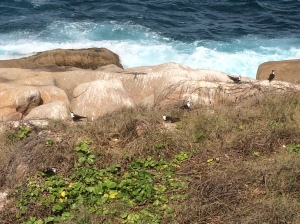On 11 July 2017 Christine and I were able to revisit Cousine Island, a small private island nature reserve off the western coast of Praslin. Like most

Seychelles’ islands, its native forest was removed in the late 19th or early 20th century in order to make way for coconut cultivation. At that stage Sooty Terns nested on the island but their eggs were collected annually. This harvest, along with the habitat change following the planting of coconuts, eventually led to the island’s abandonment by the Sooty Terns, probably in the late 1950s or 1960s (the last recorded egg harvest here was in 1955), as happened on many of the smaller islands close to human habitation.
In 1992 the island was bought by Mr Fred Keeley. He initiated intensive and dramatic rehabilitation measures with the aim of recreating the island’s vegetation to an approximation of conditions prior to man’s interference. Most exotic plants, including even coconut and Casuarinas trees, so ubiquitous elsewhere, have been removed while endemic and indigenous trees have been allowed to proliferate or been planted from the island’s nursery to create a cover of indigenous forest. This transformation was described in a well-illustrated book “Tropical Island Recovery” (Wiley-Blackwell, 2010). It encouraged the only surviving endemic landbird, the Seychelles Fody, to proliferate, the Seychelles Blue Pigeon to colonise and allowed a small number of Seychelles Magpie Robins, which in the 1970s was reduced to a global population of only 12 birds all on Frégate Island, to be introduced: these have now established a healthy self-sustaining population on the island.
In addition, the forest supports huge populations of tree-nesting seabirds, especially Lesser Noddies and smaller numbers of White Terns. In large tree cavities and around the bases of larger trees, and also in rock crevices, White-tailed Tropicbirds and, after hatching, their “puff-ball” chicks, are extremely abundant. Wedge-tailed and Tropical Shearwaters abound in their underground burrows and at intervals of approximately 8 ½ months nesting Bridled Terns put in an appearance, nesting among rocks in more open areas, a habitat they share with the much more common Brown Noddies.


The seabird that was missing from the list of breeding birds was the Sooty Tern, and its return became a goal of the island’s rehabilitation programme. Sooty Terns often flew over the island, presumably from the nearby large colony on Aride Island. Its former nesting areas, on exposed hillsides that slope down towards the sea, had become over-run by the invasive alien plant Manztou (Asystasia gangetica). Removal of this plant and management of others to produce a patchwork of low herb vegetation and bare ground led, in 2003, to the first nesting for almost half a century. They have subsequently bre

d in small numbers in most years and in many, conservation officers have ringed chicks shortly before they fledge. During our visit, conservation officers Becky Hodgkiss and James McClelland took us to the nesting areas, one of which had about 70 nests with eggs while the other had a single nest. They showed us the present attempts to further encourage Sooty Terns to nest by placing plastic models, painted to resemble breeding adults, in the nesting areas and using loudspeakers to broadcast the calls of nesting birds in order to attract more birds. Becky and James now report that they have ringed 76 chicks that are ready to leave the colony, indicating that they have had a very successful breeding season.
Congratulations are due to Cousine Island for all its conservation initiatives and achievements – and may its Sooty Terns continue to flourish and regain their former numbers!